Six-Box Scheme Representation of Published Papers
(1) 18 Papers by Toru Nakagawa (2000 - 2016)
Toru Nakagawa (Osaka Gakuin University & CrePS Institute),
Dec. 15, 2016
Six-Box Scheme Representation of Published Papers |
|
(1) 18 Papers by Toru Nakagawa (2000 - 2016) |
|
Toru Nakagawa (Osaka Gakuin University & CrePS Institute), |
|
| Posted on Dec. 27, 2016 |
For going back to Japanese pages, press buttons.
Editor's Note (Toru Nakagawa, Dec. 25, 2016)
Three weeks ago, on Dec. 2-4, 2016, I was invited to Taiwan to conduct a 3-day workshop, "'Six-Box Scheme' of CrePS/USIT: The New Paradigm of Creative Problem Solving". Professor Daniel Sheu, National Tsing Hua University and Systematic Innovation Society, invited me. This was my first time to conduct a training seminar for 3 days in English, and was successful, I believe, thanks to Professor Sheu's support.
In this seminar I adopted a new agenda, different from my previous ones for TRIZ/USIT seminars, i.e.,
Day 1: Understanding the concept of the Six-Box Scheme first:
Lecture on the Six-Box Scheme and CrePS (General Methodology of Creative Problem Solving) (with Q&A); Exercises: Representing published case-studies in the Six-Box Scheme.Day 2 - Day 3: Understanding the practical methods for use:
Lecture on USIT (A concise process of creative problem solving with the Six-Box Scheme) (Q&A); Exercises: Problem solving with USIT: 'How to prevent cords/cables from getting entangled'.I have found the exercise planned on Day 1 is very productive, more than I expected at first. Thus after coming back from Taiwan, I have been working for 3 weeks to prepare for the Six-Box Scheme Representations of my published papers as posted here both in English and in Japanese.
Please refer to '1. Preface' below concerning to my intention.
The present page posts the Six-Box Scheme representation of my 18 papers published every year since 2000 at conferences both in English and in Japanese (See the table of papers). In addition to the present page in HTML with images, the PDF version
is also posted. You can learn the concepts of the Six-Box Scheme, how to describe the overview in the Six-Box Scheme, and how the Six-Box Scheme has been developed, etc.
At the end of this page, you may see a brief explanation on how to describe in the Six-Box Scheme, and also the Six-Box Scheme Templates in PowerPoint
and in Word
.
|
|
Six-Box Scheme Representation of Published Papers
(1) 18 Papers by Toru Nakagawa (2000 - 2016)
Toru Nakagawa (Osaka Gakuin University & CrePS Institute)
Dec. 15, 2016
1. Preface (Toru Nakagawa, Dec. 15, 2016)
Six-Box Scheme is the new paradigm of creative problem solving, which I found in 2004 through my work related with TRIZ and USIT and I have been promoting actively since 2012 in much more general context.
'Creative problem solving' implies a wide range of intellectual activities;
not only solving difficulties/undesirables (i.e., problems) but also achieving goals/desirables (i.e., tasks),
not limited to inventions/discoveries but including ordinary intellectual works,
academic or non-academic, theoretical or practical,
published or not, completed or not, etc.Till recently, for the purpose of demonstrating the Six-Box Scheme, I was trying to make a new case study of applying USIT (or other) method to some problem by following the Six-Box Scheme. Thus the demonstration has been done slowly only in a small number.
But I now realize that almost all serious intellectual works, such as published papers, can be represented in the Six-Box Scheme, because of its generality as the basic paradigm. Some works may emphasize some part and skipping some other part of the Six-Box Scheme. That's fine. Six-Box Scheme plays the role of template for describing intellectual works, just like the standardized patent format.
Thus I started to represent my own published papers in the standard format of Six-Box Scheme. I tried it first for my ETRIA TFC papers presented in 2002, 2004-2005, 2012, and 2014, because they are important for me. Then, having found the representation meaningful, I described all my ETRIA TFC (or TRIZCON) papers published every year from 2000 through 2016 in the Six-Box Scheme, as you see here.
Every published paper can be represented meaningfully in the Six-Box Scheme. You may also trace how the concept of the Six-Box Scheme has been developed through these works.
2. Table of Papers (by Toru Nakagawa) Represented Here in the Six-Box Scheme
3. Papers by Toru Nakagawa (2000 - 2016): Abstracts and Six-Box Scheme Representations
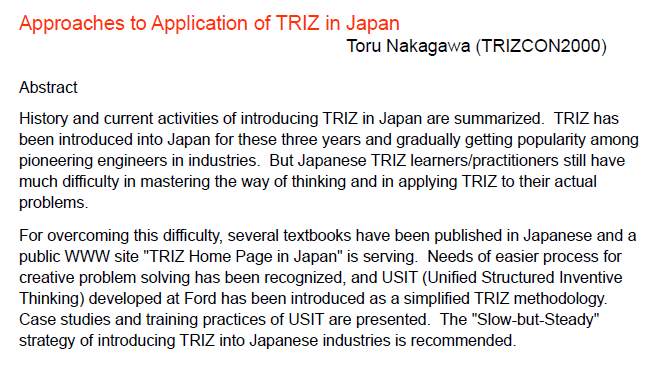
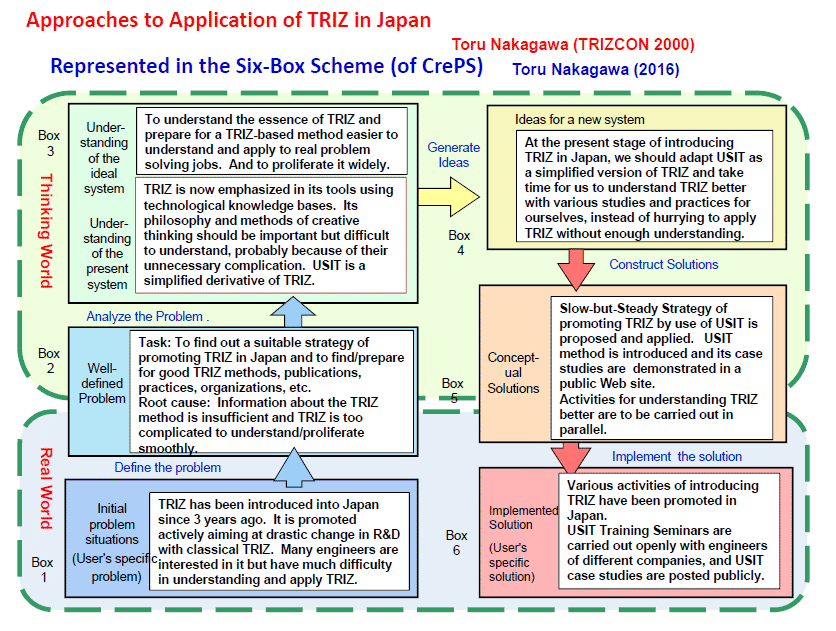
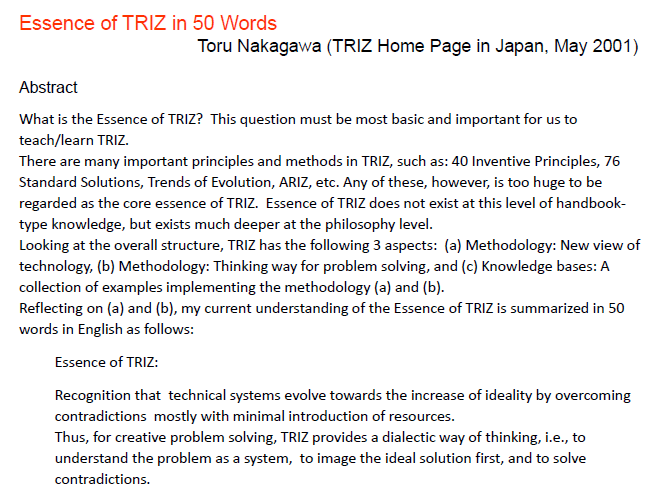
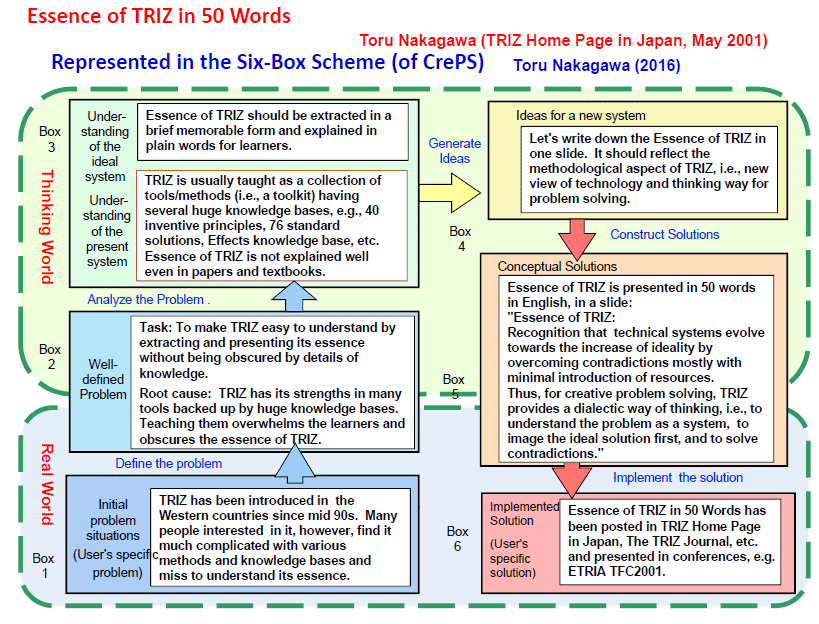
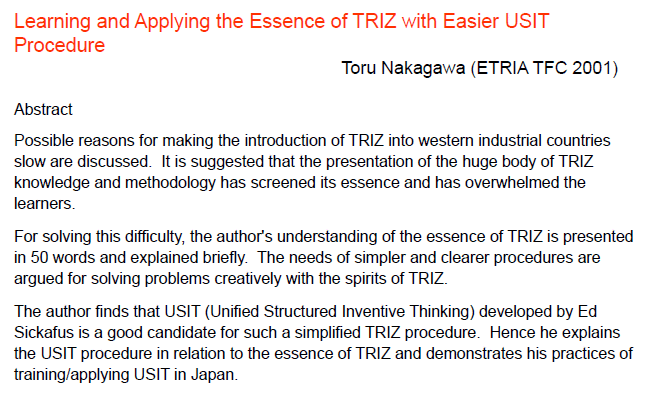
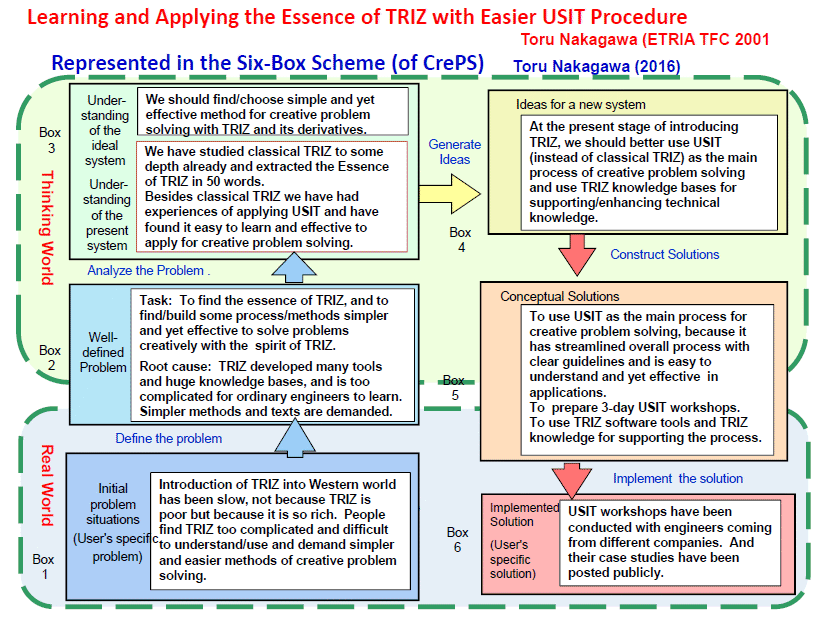
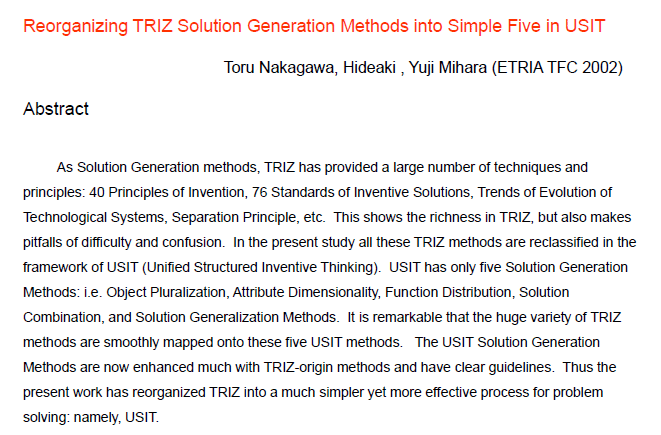
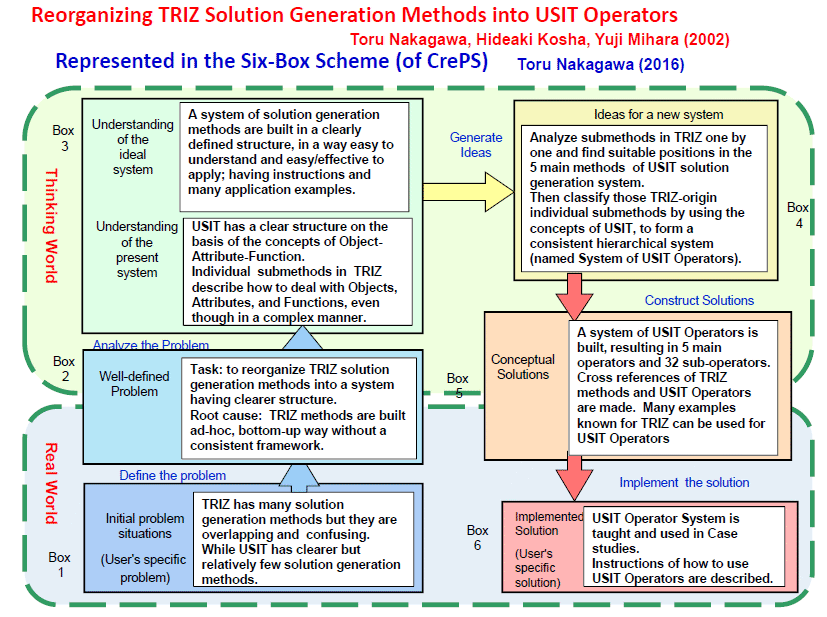
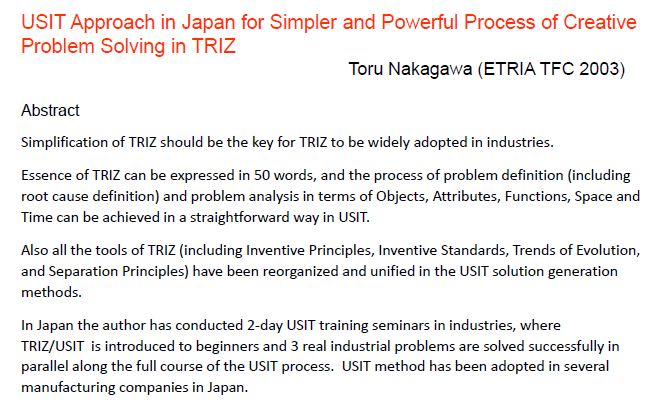
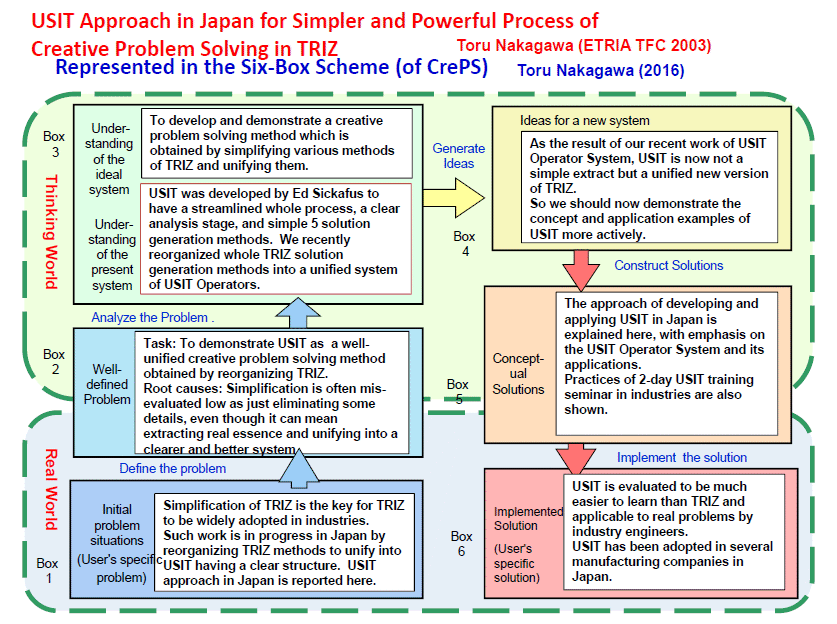
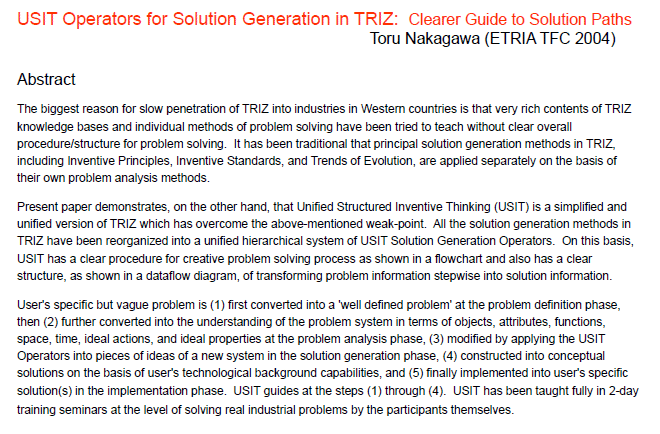
Note: This paper (2014) and the next paper (2015) are represented together in a Six-Box Scheme Overview; see below.
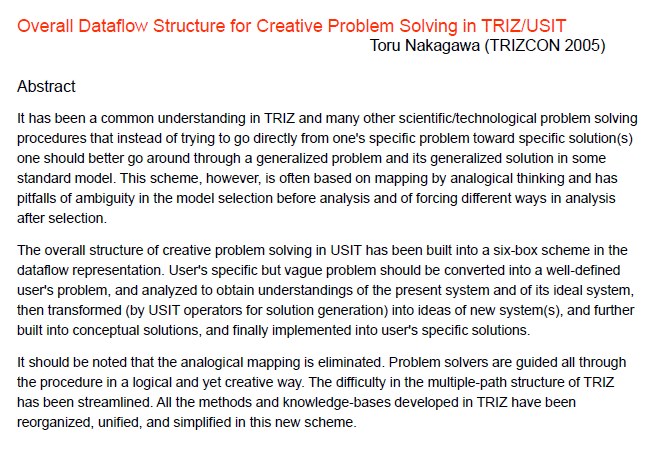
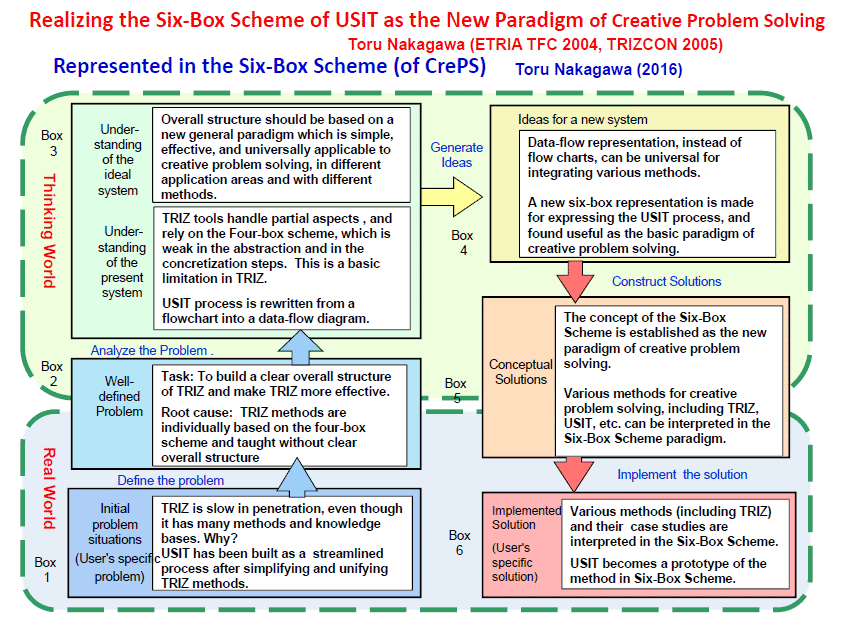
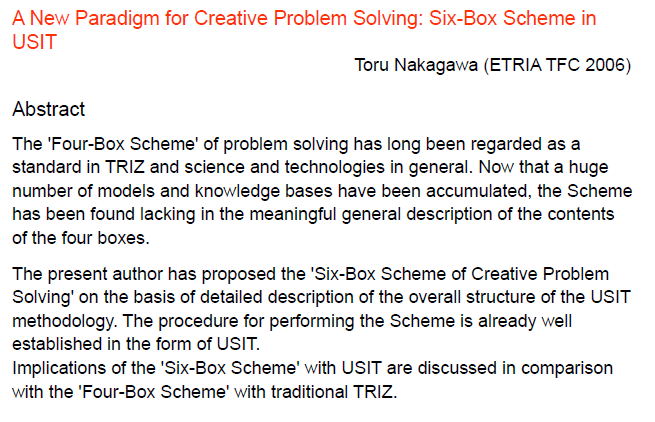
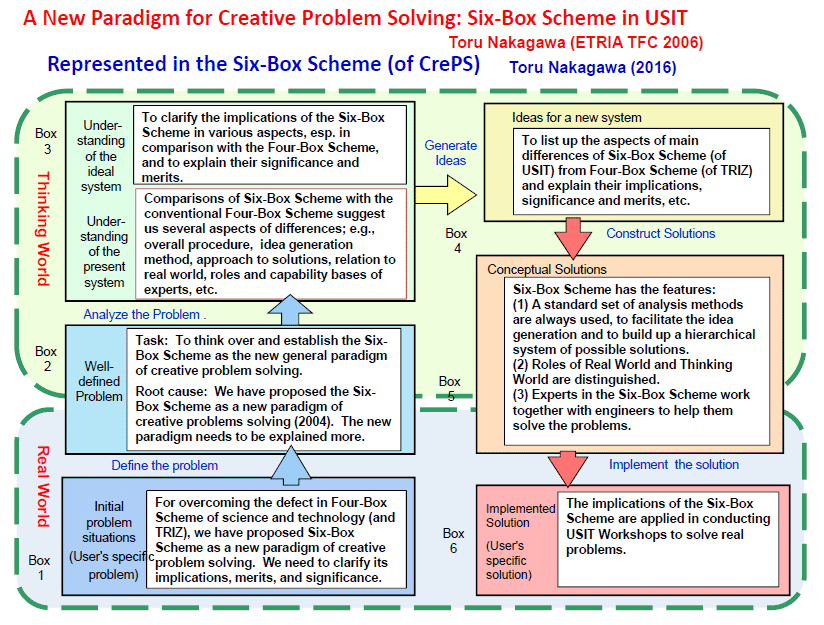
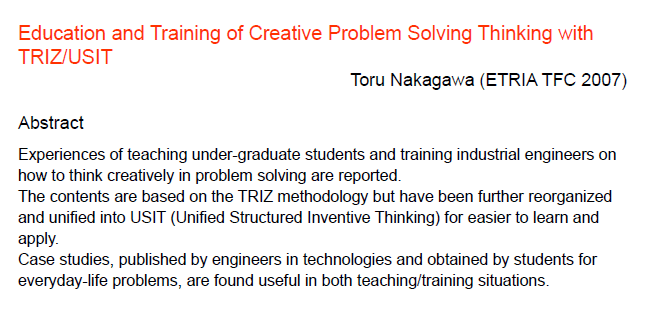
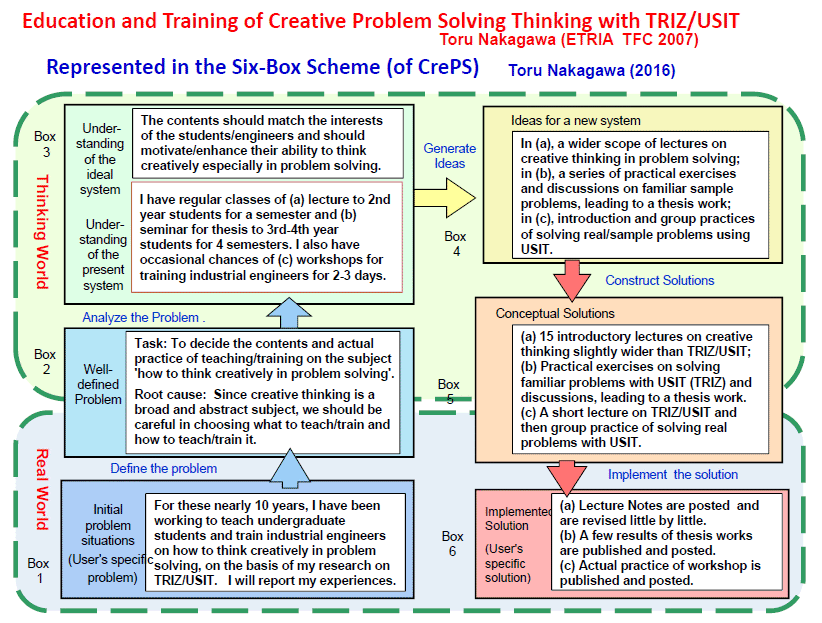
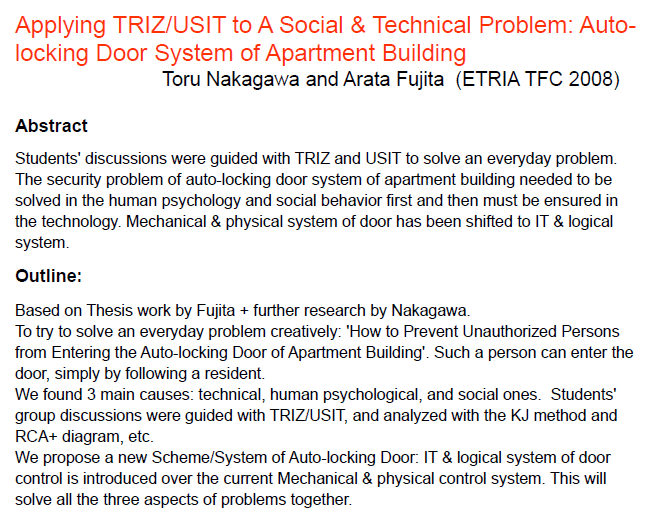
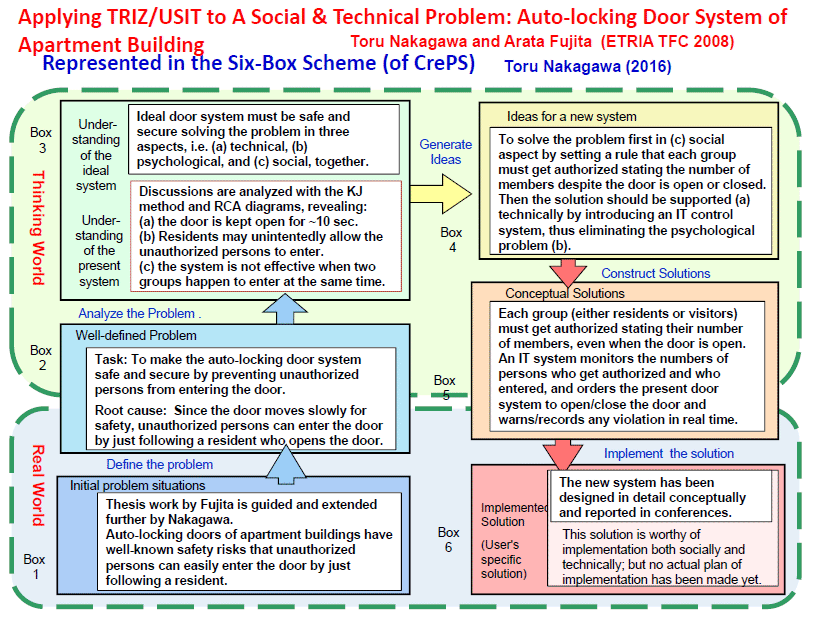
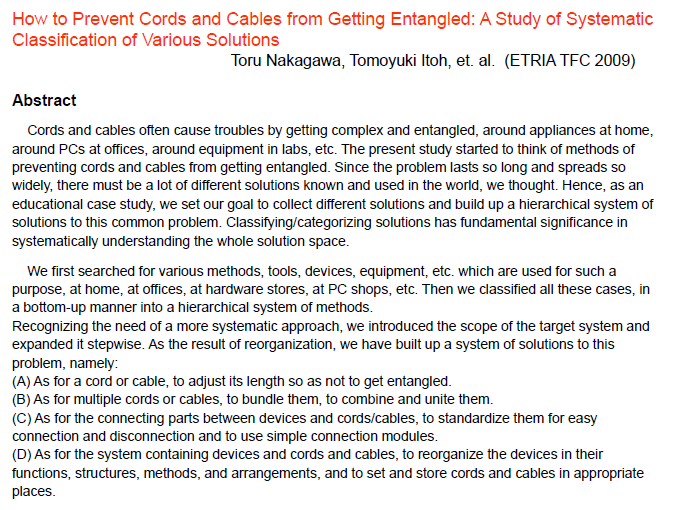
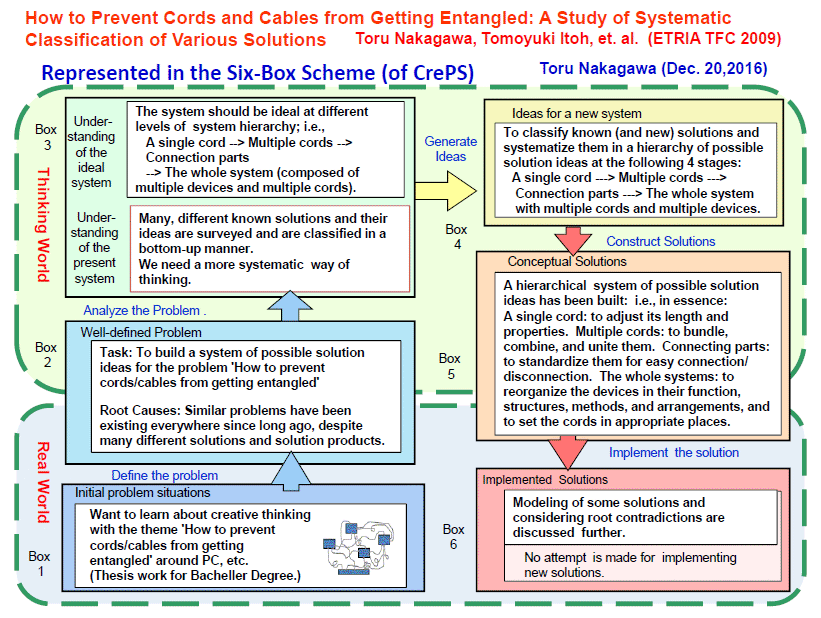
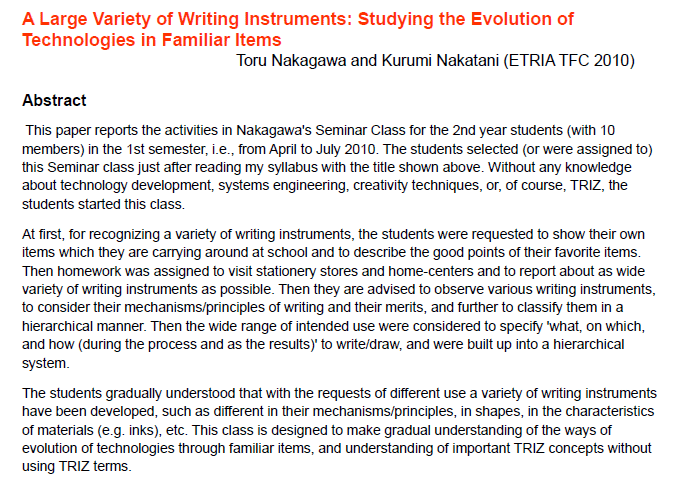
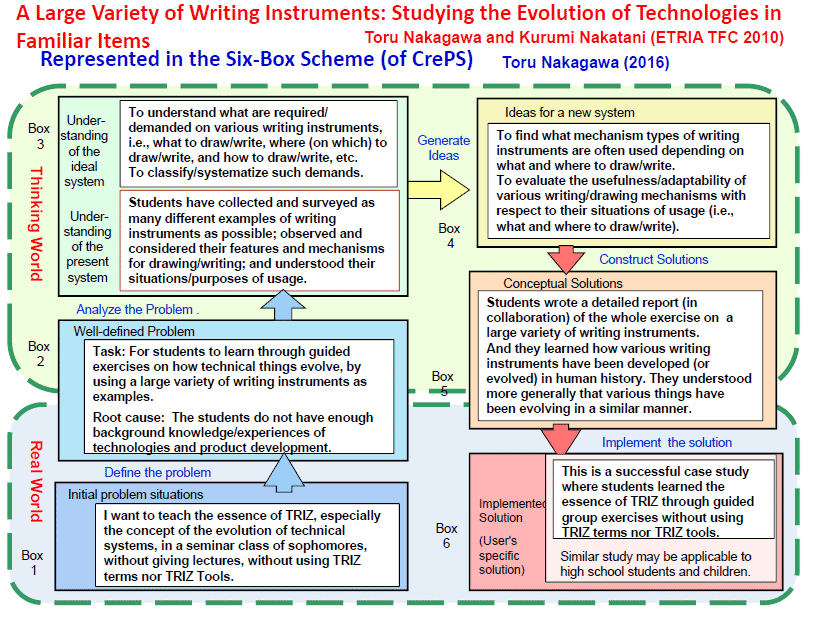
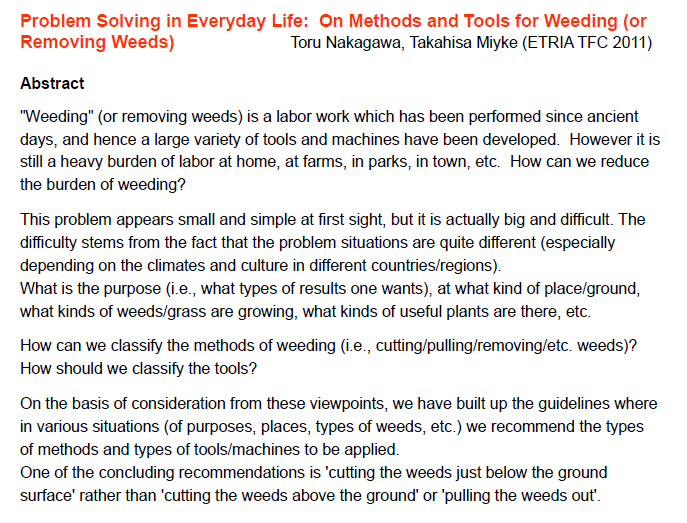
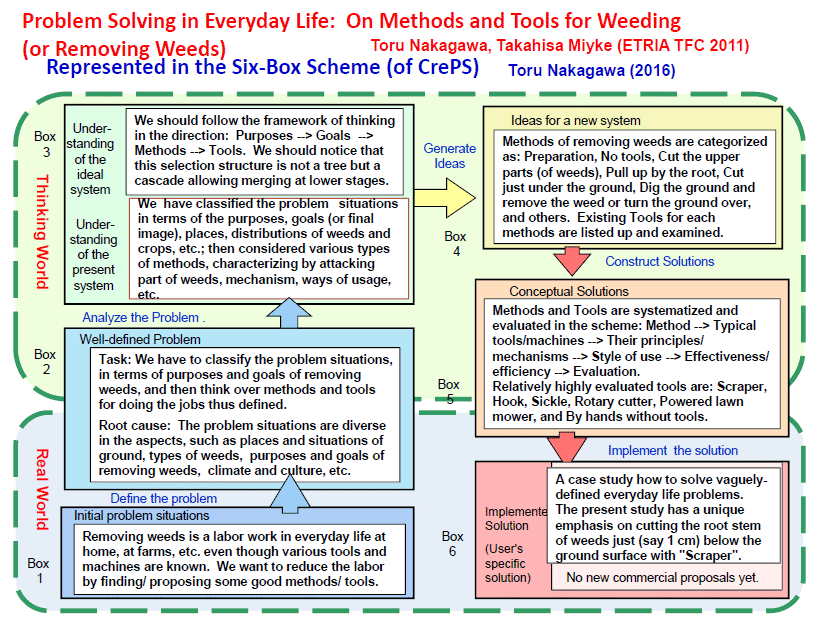
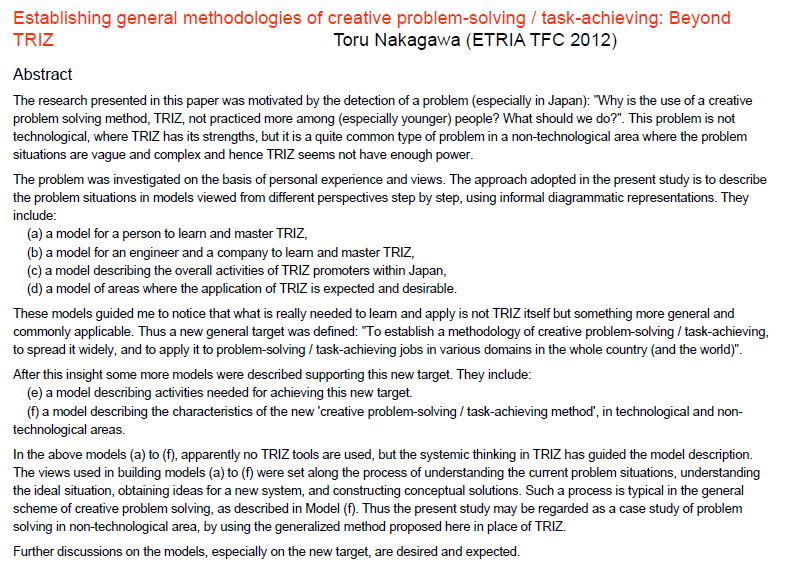
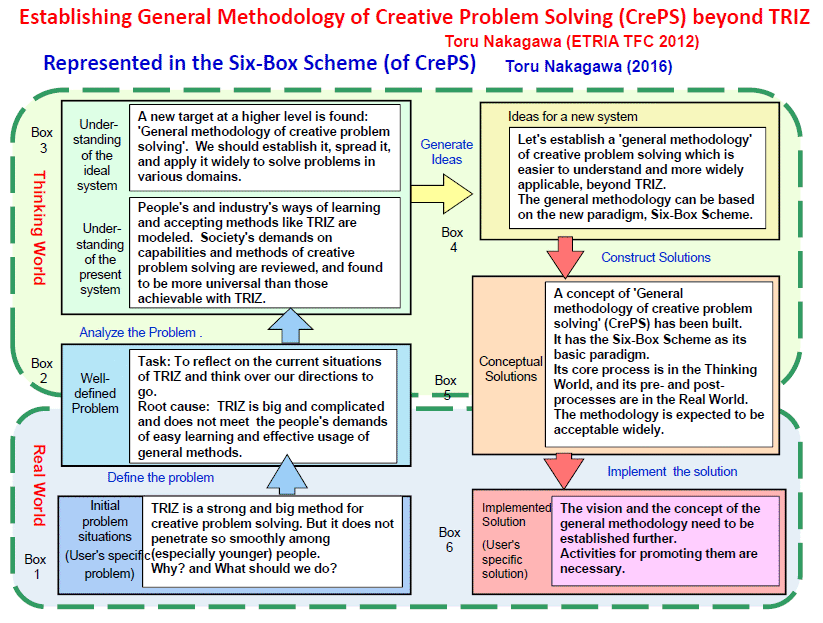
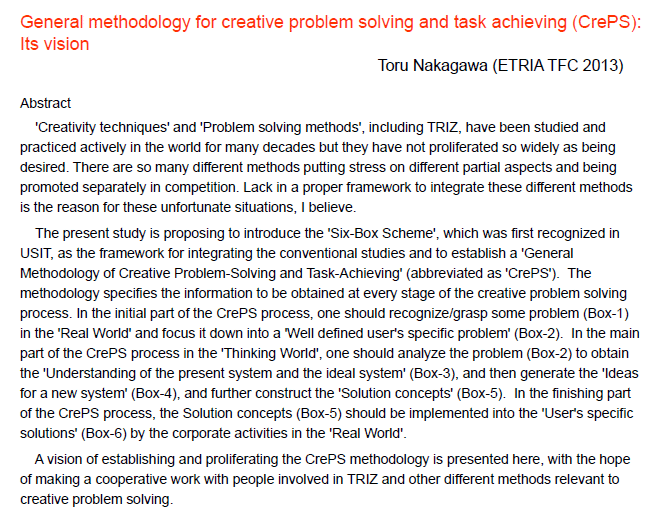

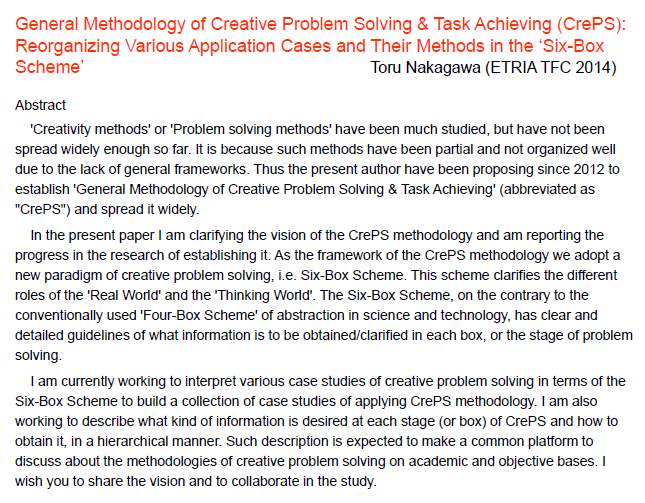
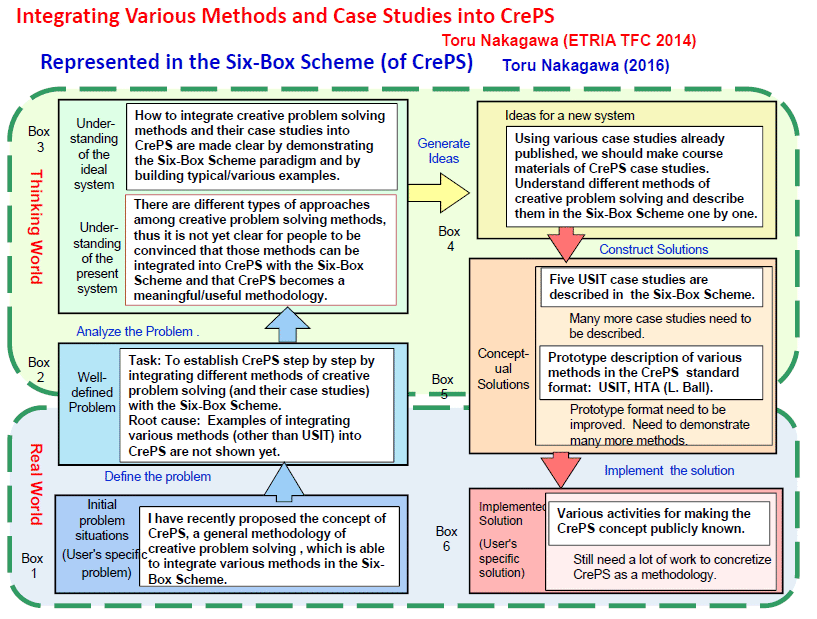
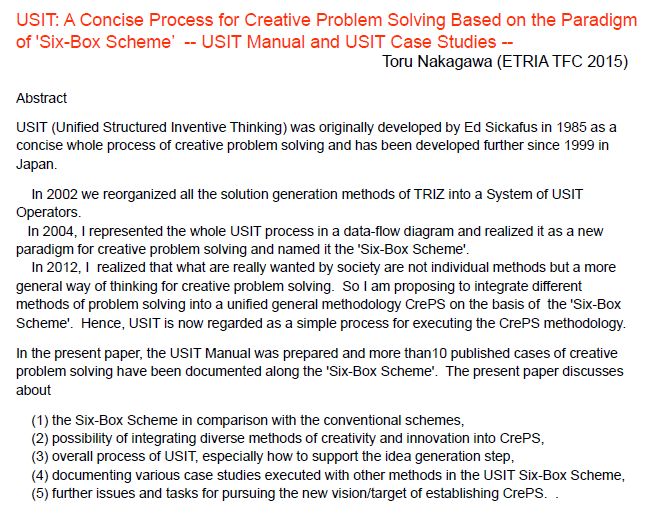
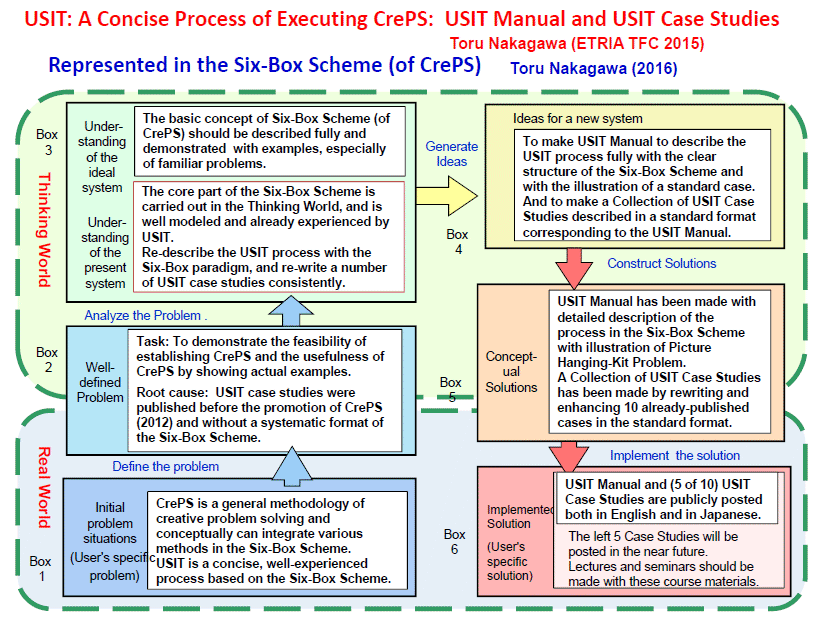
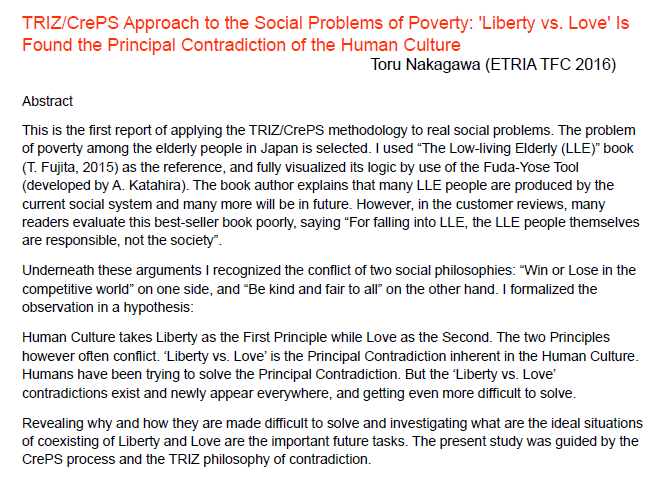
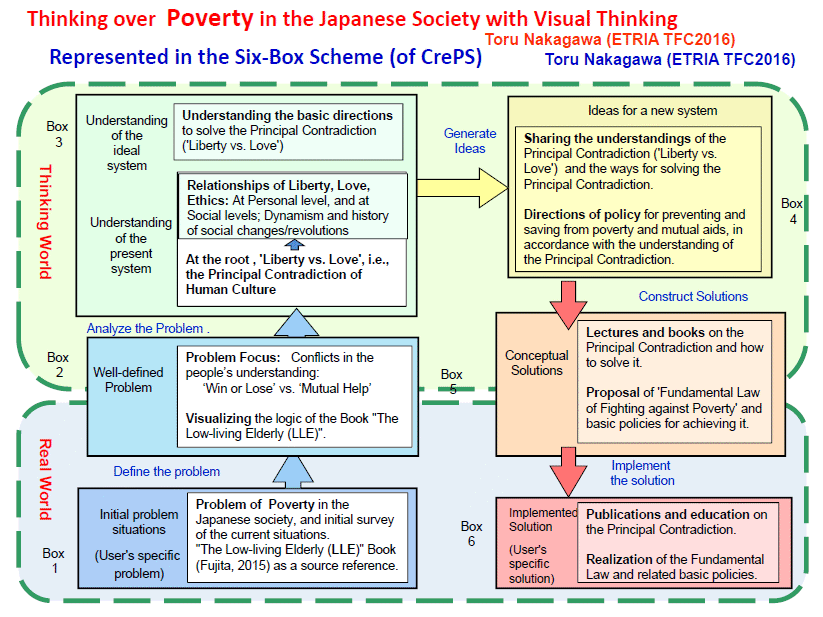
Editor's Note PostScript (Toru Nakagawa, Dec. 24, 2016):
Brief Instructions of How to Describe in the Six-Box Scheme Representation
For you to read/take a look at a series of papers represented in the Six-Box Scheme, here are brief instructions and comments:
(1) Concerning to the concept of the Six-Box Scheme, its process of solving problems, and the information to be obtained in each stage (or Box), please refer to the paper (2015)
, especially the 'USIT Manual'
.
(2) Each paper is shown here as a pair of Abstract (at the time of publication) and 'Overview represented in the Six-Box Scheme' (described newly).
(3) The Overview need to be described concisely in one-slide format. It is often hard to write it concisely. You may find similar hardness in writing Abstract appropriately. Since the Overview requests to fill each box with the category of information as specified, you should be even more thoughtful than to write Abstract.
(4) Abstracts of papers (i.e., reports of creative problem solving) often miss enough information requested for the Six-Box Scheme representation. For making the Overview slides of my 18 papers, I read the slides of my original presentations closely again. I found it important to describe a paper in conscious of the stages along the Six-Box Scheme.
What was really needed to overcome? What was the direction to ideal solutions? What was the real essence of the work achieved (or ideas)? How much were the conceptual solutions really implemented? etc. are the points needing much reflection.(5) In the Box 2 (of the Overview format), only two items, i.e., Task statement and Root causes, are described due to the limitation in the space. The flow of thoughts may be (coming from the bottom, Box 1: Problem situations, to Box 2) Root causes and then Task statements. Similarly, in Box 3, you may think of 'Understanding of the present system' and then 'Understanding of the ideal system'. Following such a sequence, you may smoothly come to Box 4: Ideas for a new system.
(6) For a paper of a completed work, it is not so difficult to describe the work in the Six-Box Scheme representation. For a work still under the way, on the other hand, you need to describe it in such a position in the Six-Box Scheme. For distinguishing the item of information actually obtained from the one just anticipated, I used ordinary white textboxes for the former while pale colored textboxes for the latter, in the Overview format.
(7) It is not easy to write a concise Overview for the cases when the work is proceeding in multiple branches or in multiple stages/cycles in history. It may be reasonable to describe multiple sets of Overview of some proper branch/stage/cycle. Or else you may describe an Overview as a big work without mentioning details.
(8) A template for describing the Overview in the Six-Box Scheme is made with PowerPoint
. You may download and use it freely.
(9) For writing a big and complex work (or paper), you may prefer a flexible format without limitation of space, instead of a single slide. For such a purpose, another template in MS Word
is also posted. The format is arranged from Box 1 at the top straight down to Box 6 at the bottom. You may use any number of lines for each box as you like.
Templates of the Six-Box Scheme Representation (Click the figure for downloading)
|
|
Last updated on Dec. 27, 2016 Access point: Editor: nakagawa@ogu.ac.jp